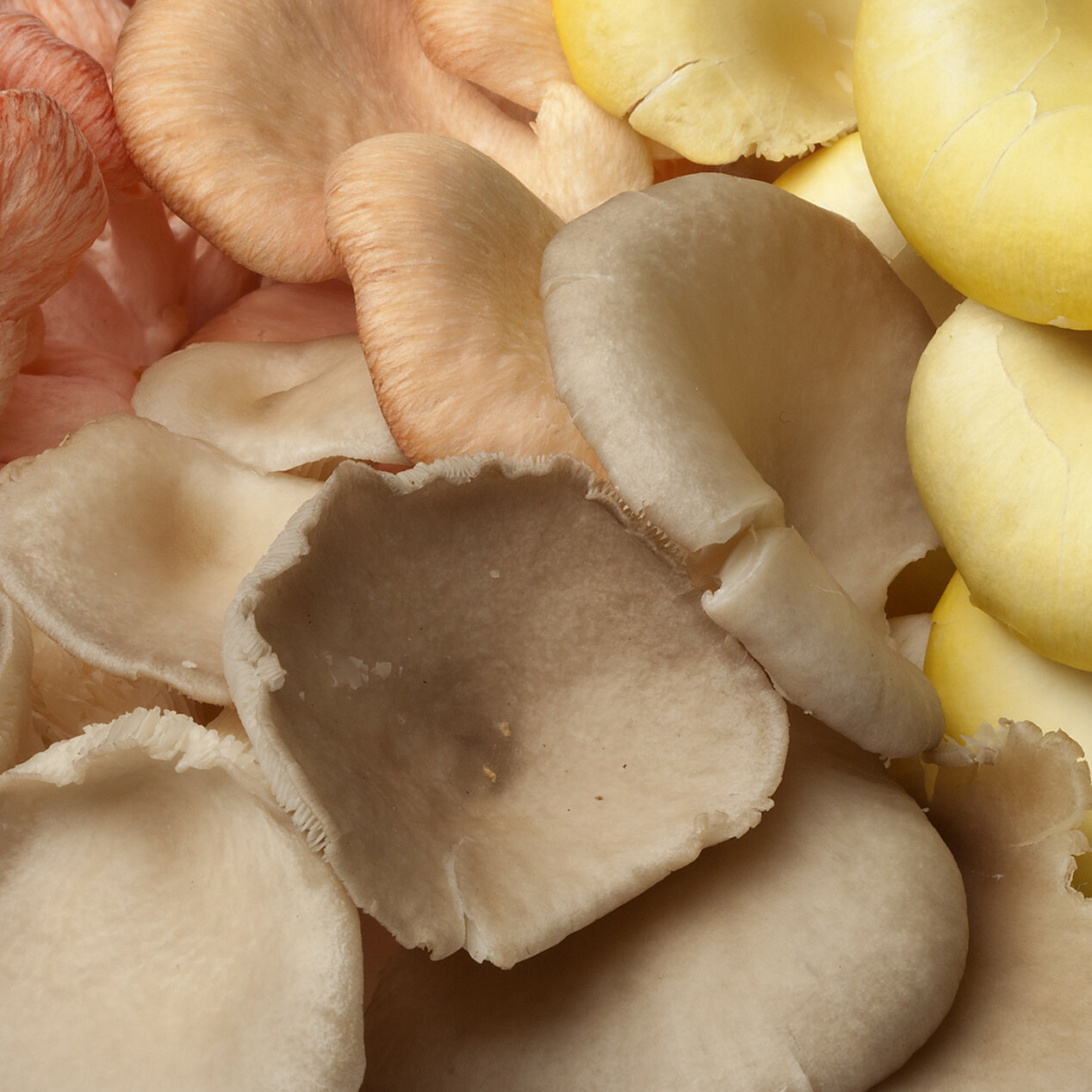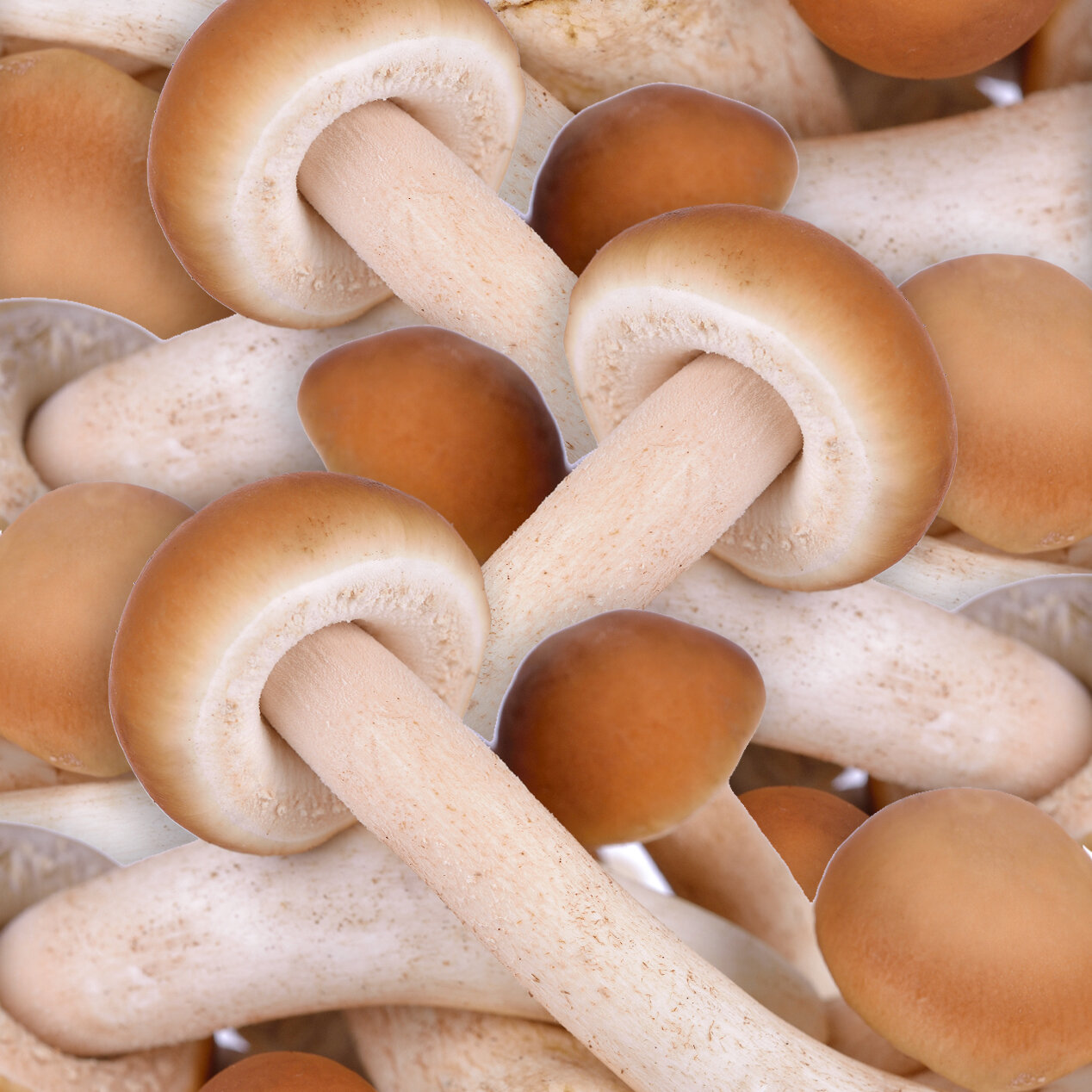
VARIETIES
WHAT WE OFFER
Below is an overview of what we offer. We may have more or less depending on the time of year, but these are our flagship varieties and a little info about each.
Shiitake
Taste: Shiitake have a soft spongy quality with a woodsy umami flavor and are a bit chewier and meatier than most mushrooms when cooked.
Culinary: Most cooks use Shiitake caps sliced and added to sauces, sautéed or as an addition to pasta, saving the more fibrous stems for stocks or reductions. The lower water content of the Shiitake as compared to many other mushroom varieties enables them to hold shape and texture better in sauces and soups. Drying Shiitake is also a great way to stretch out the life of the mushroom, and dehydrated Shiitakes are prized for their rich flavor and ease of use.
Healing: Analysis of multiple clinical trials show that active ingredients found in L Edodes can increase survival rates for cancer patients by close to 20%. 5 clinical cancer trials totaling 650 participants showed that the addition of Lentinan (a highly purified polysaccharide found in L. Elodes) at 2mg/week found it gave a significant advantage over chemotherapy alone in survival rates. Another bioavailable ingredient in L Edodes, Eritadenine has been shown in studies to cut cholesterol significantly in as little time as one week. L Edodes has been researched as a treatment for Hepatitits B, HIV and Anti-candidal action, L Edodes is also an excellent source of B Vitamins and pro-vitamin D2.
Nutrition: Per the USDA a 1-cup serving (86g) of raw, sliced shiitake mushrooms:
Fiber: 2g
Potassium: 261mg
Sugars: 2.1g
Protein: 2g
Niacin: 3.3mg (21%DV)
Pantothenic Acid: 1.3mg (26%DV)
Vitamin B6: .252mg (19%DV)
Calories: 29
Calcium: 1.7mg
Fat: 0.4g
Iron: 0.35mg
Sodium: 7.7mg
Carbohydrates: 5.8g
Vitamin D (D2 + D3): 18IU
Oyster
Taste: Delicate texture and mild savory flavor.
Culinary: Their mild flavor works well in a variety of dishes and is why we refer to Grey/Blue Oysters as our “workhorse” mushroom. Frying, roasting and grilling will retain more texture while braising and sautéing makes them softer. Oyster mushrooms also respond well to braising, making them perfect for soups/stews and sauces. They can also be grilled on skewers, roasted or dredged and deep fried. As with all mushrooms, Oysters will soak up water and become hard to work with. Dried Oysters react well to being added directly to a dish, there is no need to rehydrate them.
Healing: Many studies show that the high lovastatin levels in Oyster Mushrooms aid in lowering cholesterol levels. New research shows that the polysaccharides present in Oyster mushrooms show anti tumor effects. A few clicks through pubmed online show multiple studies about the cioactive components of Pleurotus.
Nutrition: Per the USDA a 1-cup serving (86g) of raw, sliced oyster mushrooms:
Phosphorus: 103mg
Fiber: 2g
Potassium: 361mg
Sugars: 0.95g
Vitamin A: 41.3IU
Protein: 2.9g
Vitamin D (D2 + D3): 25IU
Calories: 28
Calcium: 2.6mg
Fat: 0.3g
Iron: 1.1mg
Sodium: 15.5mg
Magnesium: 15.5mg
Carbohydrates: 5.2g
King Oyster (King Trumpet)
Taste: The broad fibrous texture lends itself well to marinating and taking on the flavor of sauces, and holds up well in soups and stir fries.
Culinary: When sautéed or baked to a golden brown kings have a meaty almost pork like taste and can be fried into chips. Often people will cut them into rings resembling a scallop and sauté them and sauce them as you would a sea scallop.
Healing: King Oyster/Trumpet contain high amounts of the amino acid Ergothioneine which is an powerful antioxidant. Kings have also been studied for their ability to lower cholesterol levels which may be due to lovastat, a cholesterol blocker.
Nutrition: Per the USDA a 1-cup serving (100g) of raw, sliced king oyster mushrooms:
Calories: 33
Calcium: 4mg
Fat: 0.41g
Iron: 1.3mg
Sodium: 246mg
Niacin: 5mg
Carbohydrates: 6.1g
Phosphorus: 120mg
Fiber: 2.3g
Potassium: 420mg
Sugars: 1.1g
Protein: 3.3g
Lion’s Mane
Taste: Fresh Lion’s Mane is a cascading pale white to rusty brown with a texture and flavor reminiscent of blue claw crab meat.
Culinary: Though most frequently used in powder form as a supplement, the texture and flavor are choice edible and able to be used in a variety of different methods.
Healing: Most people come across Lion’s Mane to utilize its nootropic (neural path connecting) benefits. Traditional Chinese medicine has been using Lion’s for centuries for its cognitive boosting benefits and only recently has science been testing it and beginning to prove its relationship to rebuilding neural connections. It is being used experimentally to assist in treating Parkinson’s, peripheral neuropathy, seizures, anxiety, depression and in aiding memory function.
Nutrition: Per the USDA a 1-cup serving (100g) of raw, sliced lion’s mane mushrooms:
Calories: 33
Calcium: 2mg
Iron: 0.41mg
Sodium: 10mg
Carbohydrates: 7g
Potassium: 304mg
Protein: 2g
Pioppino
Also Known As: “Velvet Pioppino”/Poplar Mushroom/Tea Tree Mushroom
Taste: Pioppino have a lower water content than most mushrooms and because of this are prized for how they keep their shape and hold up through the cooking process. They have a faint floral aroma and are meaty and crunchy with a nutty, slightly sweet, peppery and earthy flavor.
Culinary: Prized in Italy as an accompaniment to pastas and beef or veal dishes, Pios (or Velvet Pioppino/Poplar Mushrooms) present themselves as a versatile & unique ingredient. The texture of the mushroom allows it to hold firmly in a pasta sauce, creating a distinct contrast with the other ingredients in the dish. Utilizing the Pioppino as a crunchy sautéed accompaniment to a beautifully seared steak or veal adds a dimension of culinary ingenuity.
Healing: Traditional Chinese medicine has used the Pioppino for wellbeing of the stomach and to keep the kidneys working properly. Present day science recognizes Pio’s for having anti-inflammatory, antifungal, antibiotic and anti-tumour properties. Pio’s contain metabolites including Cylindan which has anti-cancer properties and was detailed in the 2009 book Biotechnology in China I: From Bioreaction ot Bioseparation and Bioremediation.
Nutrition: Per the USDA a 1/2cup serving of raw, sliced pioppino mushrooms:
Calories: 20 calories
Carbohydrates: 4g
Fiber: 2g
Sugar: 2g
Protein: 2g
Iron": 8mg
Maitake
Commonly foraged mushroom known as “Hen of the Woods” to the forager.
Taste: Firm fronds hold well to a sauté and have a distinct rich umami flavor that puts them in a category of their own. Distinctly robust and opulent, they are the prize of the forager and Michelin Star chef alike.
Culinary: Roasted? Sautéed? Incorporated into a simple everyday broccoli casserole? All the correct uses. The richness of the Maitake lends itself well to family favorite recipes (in a stroganoff? How about a pot pie?). A simple sauté with some butter and garlic shows the unique and unforgettable flavor of this mushroom. The more you experiment, the more you’ll enjoy showing off the power of the Maitake.
Healing: Japanese and Chinese medicine have been utilizing Maitake to support the immune system. Western medicine has shown through studies that white blood cell activity and production is increased with Maitake ingestion. Being that Maitake are high in antioxidants, it follows that they benefit brain health by reducing oxidative stress. As a whole, Eastern medicine has been using Maitake for treatment of multiple ailments for generations, while Western science is only recently investigating and proving some of these treatments.
Nutrition: Per the USDA a 1 cup serving of raw, diced maitake mushrooms:
Calories: 26
Protein: 1.4g
Carbohydrates: 4.8g
Dietary Fiber: 2g
Sugars: 1.4g
Total Omega-6 Fatty Acids: 63mg
Folate: 20mcg
Phosphorus: 52mg
Potassium: 143
BEECH
Taste: Nutty and crunchy, satisfyingly sweet and delicately mild.
Culinary: As with all gourmet mushrooms, the creative chef will find the Beech highly versatile. It pairs well with garlic or shallots and strong, savory herbs, and is traditionally incorporated in a variety of cooking methods, most frequently soups, sauces & stir frys. Within stocks, soups or sauces, the Beech complements tomatoes, red bell peppers, and citrus fruits. It is ideal for tempura also.
Healing: Beech has been used for weight loss, diabetes management and anti-inflammatory purposes in Chinese medicine. It has been found to be rich in calcium, potassium, phosphorus, and iron.
Nutrition: Per the USDA a 100g serving of raw, sliced beech mushrooms:
Protein: 2g
Carbohydrate: 6g
Dietary Fiber: 4g
Sugars: 0g
Vitamin D: 1.3mcg
Vitamin C: 3g
Vitamin B6: 104mcg
Niacin: 670 mcg
Black Pearl
A cross between Grey Oyster and King Oyster/Trumpet
Taste: An obvious combination of the Grey and King Oyster (Trumpets), the Black Pearl shares characteristics of both mushrooms. Rich and more rigid than Grey Oysters, Black Pearls have a similarly nutty, earthy flavor.
Culinary: These are terrific sautéed and seasoned as a side, but really shine as a creative ingredient. Diced, sautéed and baked until crispy, Black Pearls make unique and flavorful croutons to be used in soups or salads. Cut horizontally into rings and use as an addition to any stir fry or side dish. The culinary uses are endless and ever so unique because the mushroom itself is a new variety that is only beginning to see its potential uses explored.
Healing: Unused in generational Chinese/Japanese healing because of its recent addition to commercial cultivation. Black Pearls also haven’t been extensively studied in Western medicine to date.
Nutrition: Similar in content to Grey Oyster and King Oyster/Trumpet.








